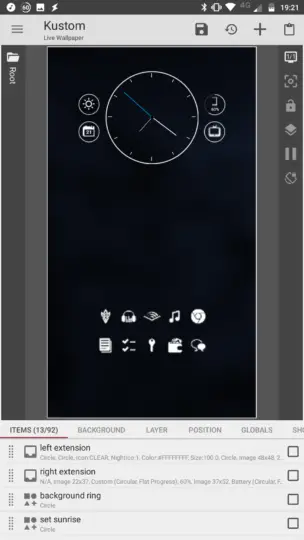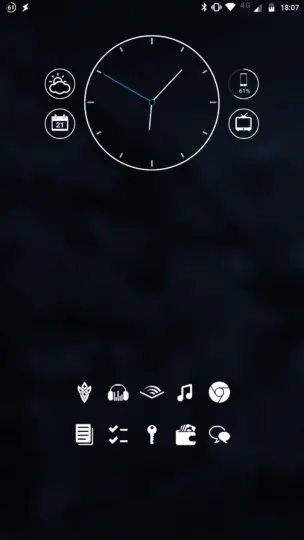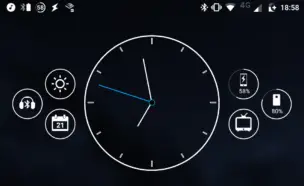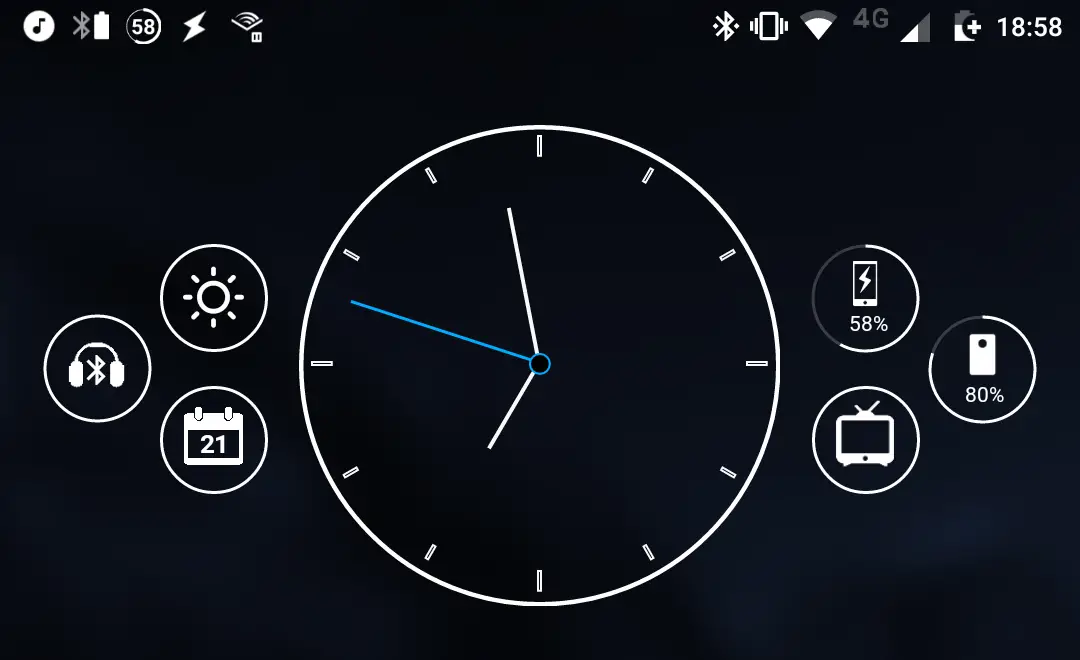KLWP is my second favorite customization app after Tasker
My love for Tasker (and its add-ons) is, shall we say, well documented. In the last year, however, it has been joined by another customization app that has plenty to offer people like me who like to make their phone their own: Kustom Live Wallpaper Maker (KLWP).
 KLWP and its sibling, Kustom Widget Maker (KWGT), both offer ways to make your own homescreen UIs. Whereas KWGT does this by letting you create widgets, KLWP does it by letting you create your own interactive live wallpapers. These aren’t your traditional “videos” playing as your wallpaper, however, and can be better described as full screen megawidgets that can entirely replace everything on your homescreen, be it icons, widgets, or the need for multiple screens. In comparison, the widget version is a simpler, but more limited alternative that just places widgets on your homescreen along with everything else. They share an editing UI, which uses a combination of a WYSIWYG UI and “formulas”, small scripts with its own syntax that process information like grabbing weather info for a specific day. KLWP and KWGT share many of the same features, but with some differences due to what the underlying “platform” (live wallpapers or widgets) are capable of. While KWGT is great on its own, KLWP is what has made me invest time and effort into learning how to use it fully.
KLWP and its sibling, Kustom Widget Maker (KWGT), both offer ways to make your own homescreen UIs. Whereas KWGT does this by letting you create widgets, KLWP does it by letting you create your own interactive live wallpapers. These aren’t your traditional “videos” playing as your wallpaper, however, and can be better described as full screen megawidgets that can entirely replace everything on your homescreen, be it icons, widgets, or the need for multiple screens. In comparison, the widget version is a simpler, but more limited alternative that just places widgets on your homescreen along with everything else. They share an editing UI, which uses a combination of a WYSIWYG UI and “formulas”, small scripts with its own syntax that process information like grabbing weather info for a specific day. KLWP and KWGT share many of the same features, but with some differences due to what the underlying “platform” (live wallpapers or widgets) are capable of. While KWGT is great on its own, KLWP is what has made me invest time and effort into learning how to use it fully.
 My current KLWP homescreen is the result of gradually learning how to use the app and its many features. In the beginning I had some basic widget-like functionality alongside icons added on top of the wallpaper by the launcher, but I eventually moved to a setup where everything on my screen is part of the live wallpaper. At first glance it looks like a normal homescreen with some widgets and icons, but having full control over the UI means there’s a lot that works quite differently.
My current KLWP homescreen is the result of gradually learning how to use the app and its many features. In the beginning I had some basic widget-like functionality alongside icons added on top of the wallpaper by the launcher, but I eventually moved to a setup where everything on my screen is part of the live wallpaper. At first glance it looks like a normal homescreen with some widgets and icons, but having full control over the UI means there’s a lot that works quite differently.
One difference is that instead of using folders, I can dynamically add rows of icons by having some of the default icons toggle those rows. The wallet icon toggles a PIM (Personal Information Management) row, the chat icon toggles a communication row, and the document icon triggers some file handling apps. In addition, the Audible icon makes Audible’s own widget pop up as an overlay via this app, and the headphone icon makes the bottom of the screen become a music widget. I have direct control over how all of this looks, every pixel of it, so I’m not restricted to existing widgets, launcher folders, and so on. The icons can also be a lot more advanced, and while most of mine are just single icons, the step counter (visible in the top left part of the image below) is one example where part of the icon is dynamic text, something normal icons can’t do. The icons around the clock are also mostly dynamic in some way. ![]()
Another advantage of having the icons be part of the wallpaper is that you can hide them when you need to. I use this for the info “widgets” I have added to my KLWP setup, which includes a calendar, more detailed step counter information (toggled by the before-mentioned step counter icon), weather information, Trakt widget, and a relative map of my most used bus stops that link to real time departure information overlays for those stops. These are toggled by icons that are either part of the bottom icon rows or the icons around the clock. If I need more space for these widgets than what’s left between the clock and the icons, I can just have the icons disappear. This is essentially an alternative to having multiple screens, but gives you more control as I can for instance keep the clock, switch out one of the icons around it with a refresh button, and so on.
These widgets are also very custom. The two calendar widgets (agenda and month) are so-called Komponents, groups of elements that can be shared between users, and downloaded as separate packs on Google Play (put there by other users). Thanks to this feature, I was able to just download this and this Komponent from Google Play and have calendar functionality in my live wallpaper long before I was capable of making something like that myself. The weather screen was my own first foray into creating a Komponent, while the Trakt screen was my most ambitious one yet, as I created its entire back end in Tasker and then incorporated the data into KLWP using JSON – but more on that in a later, separate article.
Tasker and KLWP actually work very well together. There’s a rudimentary plugin for Tasker to send information to KLWP, but there are also “incidental” ways to have the two communicate, such as launching shortcuts to Tasker tasks from KLWP, sending info along with it via AutoTools, and exchanging large amounts of information at once using AutoTools, JSON, and JSONpath.
Of the two, Tasker is the more powerful for information processing, so using Tasker as a back end can make KLWP more powerful. Since I know Tasker better than I know KLWP, I use Tasker to control what elements should be visible on screen, hiding icons or info screens when others are visible, and so on. You could do a lot of this in KLWP itself, but I find that whenever I try to do so, I come across a bug or limitation that makes me go back to Tasker. For me, it’s best to make the KLWP implementation as simple as possible, leaving the heavy duty work to my one true love, Tasker.
 I’ve also found a way to have Tasker get the battery information of connected Moto Mods and my Jaybird Freedom headphones, by using AutoNotification to steal the info from notifications. This means that I can have icons appear when they’re connected, and have the rings around them indicate battery level (100% in case of the headphones in the picture, hence the full ring, but the rings for phone and Moto Mod battery on the opposite side show this effect). This is functionality that’s so niche that KLWP would never have it on its own, and hence it shows how useful Tasker can be as a back end.
I’ve also found a way to have Tasker get the battery information of connected Moto Mods and my Jaybird Freedom headphones, by using AutoNotification to steal the info from notifications. This means that I can have icons appear when they’re connected, and have the rings around them indicate battery level (100% in case of the headphones in the picture, hence the full ring, but the rings for phone and Moto Mod battery on the opposite side show this effect). This is functionality that’s so niche that KLWP would never have it on its own, and hence it shows how useful Tasker can be as a back end.
All of this is just my KLWP setup. It can be confused with a normal homescreen because I like it like that, but there are other, far more talented KLWP creators that do much more with the tool this app offers. This Google+ community has a lot of examples, many of which can be downloaded and used on your own device.
In a nutshell, KLWP allows you to create UIs using any combination of shapes and text, with some animations thrown in for good measure, and the sky’s the limit. In the future, I’ll be posting more specialized articles about KLWP, similar to what I’ve done in the past with Tasker, including things like how to make the two communicate in other ways than the plugin. If that’s of interest, make sure to check in from time to time.



